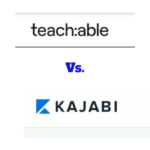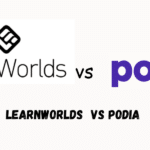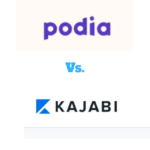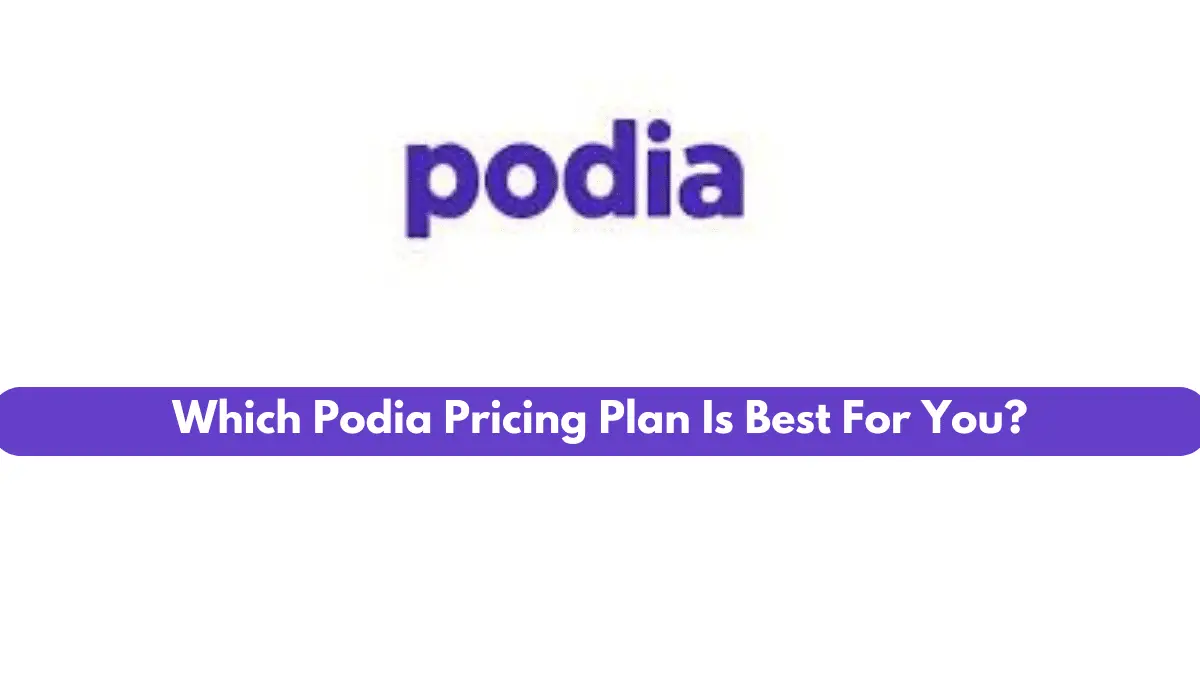
As a digital creator, you have chosen Podia which is one of the best online course platforms to sell courses, and digital products, host communities, and build websites.
But your problem now is you don’t know which Podia pricing plan is best for you.
I have explored Podia, and its pricing plans, and used the free plan to check out its features. And I will share my findings with you so you can decide which is the best Podia pricing for you as creator.
If you’re in a hurry, here is the summary of this Podia pricing review:
Mover Plan ($39/month) – Best for beginner digital creators that want basic features to create and sell digital products
Shaker Plan ($89/month) – Best for digital creators that want more marketing features Podia offers to help boost sales
Earthquaker Plan ($199/month) – Best for digital creators that want the best features to create digital products and market them
What is Podia?
Podia is a platform where you can create and sell digital products like online courses, downloads, memberships, subscriptions, and other digital products creators build. It’s one of the most affordable online course platforms where creators launch their online courses. Its features are creator-friendly, and you don’t need to be an expert in course creation to use it.
Here is an example of an SEO who uses Podia to host his subscription-based membership sites:
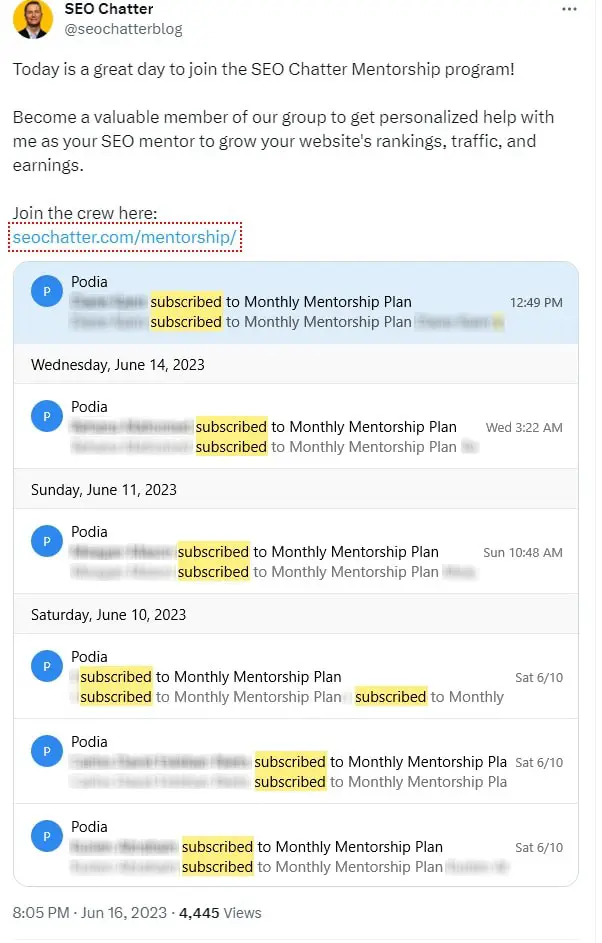
Who owns Podia?

Spencer Fry, a well-known entrepreneur owns Podia. He and his team founded it in 2014 with the aim of giving digital creators an affordable platform to sell their digital products. Fry currently serves as the CEO of Podia. And before now he has co-founded several firms like TypeFrag ( 2003) and Uncover ( 2012).
With that in mind, let’s dive into Podia pricing to see which you should choose.
Podia pricing review
Podia has 3 pricing plans:
Mover plan – $39/month
Shaker plan – $89/month
Earthquaker plan – $199/month

- Mover plan is best for beginner course creators who want basic features to create and sell digital products, especially online courses.
- Shaker plan is best for creators that want to host unlimited webinars and create affiliate programs for their digital products.
- Earthquaker is best for creators that want advanced features like onboarding and monthly creator calls, priority support, in addition to selling unlimited digital products and hosting unlimited webinars.
- No transaction is charged on all plans
- You can build a full website on all plans
- All plan support email marketing
- You can launch a full community in any of the plans
- All plans support the creation and sale of unlimited downloads
- All plans support unlimited coaching and courses creation
- All plans support live chat
- Only the Shaker and Earthquaker plans support the creation of affiliate programs for your digital products
- Only Shaker and Earthquaker plans support unlimited webinar
- Only Earthquaker plan offers priority support, onboarding calls, and monthly creator calls
- Starting a free account on the Mover, Shaker, or Earthquaker plan requires a credit card.
- Podia offers you a 17% discount when you subscribe to the annual plan of Mover, Shaker or Earthquaker
Podia’s Mover Plan Review
Mover plan is the least plan Podia offers. It’s for beginner creators who are on a tight budget and want to see if selling digital products would work for them before they decide to upgrade to a higher plan.
Who should use this plan?
A newbie digital creator that wants to create and sell online courses, digital downloads, memberships, and subscriptions and also launch a coaching program.
What about monthly and yearly pricing?
The Mover plan costs $39/month. If you pay yearly, you get a 17% discount and that’s $33/month.
What are the core features of the Mover plan?
The Mover plan offers the following features:
- No transaction fee
- Email marketing
- Full website
- Unlimited coaching
- Unlimited course creation
- Unlimited digital downloads
- Host a community
- Chat support
What are the pros and cons of the Mover plan?
Pros of Mover Plan
- Charges no transaction fee
You can create and sell unlimited courses, digital downloads, and coaching program - You can create coupons and also upsell your customers
- You can have a custom domain
You can add 1 team seat for free
Customer support is 24/7
Cons of Mover Plan
- You can’t create an affiliate program for your digital products
- Doesn’t support third-party code and embedded checkout
Podia’s Shaker Plan Review
The Shaker plan is for digital creators that want to host unlimited webinars, create affiliate programs for their digital offers, and introduce third-party tools via code to boost their marketing efforts.
Who should use this plan?
- Shaker plan is suitable for digital creators that want to boost their sales using affiliates.
- Creators who want to host unlimited webinars as a strategy to create more awareness for their products can use it.
What about monthly and yearly pricing?
Shaker plan costs $89/month. If you pay yearly, you enjoy a 17% discount and that’s $75/month.
What are the core features of the Shaker plan?
It offers the following features:
- Affiliate program to allow others promote your digital products, so you can boost your sale
- Third-party code to add marketing tools and customize features
- Host unlimited webinars
- Trigger Zapier action
- Plus every feature available on the Mover plan
What are the pros and cons of the Shaker plan?
Pros of Shaker plan
- It supports the use of affiliate
- You can host unlimited webinars
- You can use a custom domain
- You can create coupons and other upsell materials
- You can embed checkout
- You can add 1 free seat for your team
- You can turn off Podia branding
- Con of Shaker plan
- Doesn’t support monthly creator call
- No priority support
- No onboarding call
Podia’s Mover vs Shaker plan: What’s the difference?
The Mover and Shaker plan offer similar features, but there are a few differences:
- Shaker plan support the creation of affiliate while Mover plan doesn’t support it
- You can host unlimited webinars on Shaker plan while Mover plan doesn’t support the hosting of webinars
- Third-party code which you can use to customize features are available on the Shaker plan but absent on the Mover plan
- You can embed checkout on Shaker plan but not on Mover plan
- Shaker plan is a bit expensive compared to Mover plan
Podia’s Earthquaker Plan Review
This is the highest pricing plan available on Podia. It’s for creators who aren’t satisfied with the features Mover and Shaker plans offer. It supports monthly creator calls and onboarding calls. You also enjoy priority support from a dedicated support assistant.
Who should use this plan?
A creator that wants advanced features like onboarding and monthly creator calls should use the Earthquaker plan. It’s also suitable if you want a dedicated support assistant who will always assist you as long as you remain a customer.
What about monthly or yearly pricing?
The Earthquaker plan costs $199/month. It offers a 17% discount for the annual plan. So you will pay $166/month if you subscribe to the yearly plan.
What are the core features of the Earthquaker plan?
It offers the following features:
- Priority support – meaning Podia’s support team responds immediately they receive your complaint.
- Monthly creator call
- Onboarding call
- Plus all features available on the Shaker plan
What are the pros and cons of the Earthquaker plan?
Pros of Earthquaker plan
- You enjoy priority support
- You can use affiliates to boost your sales
- It supports embedded checkout
- You can use a custom domain
- You can turn off Podia branding
- Supports monthly creator and onboarding calls
- Doesn’t charge a transaction fee
- Create coupon codes and upsells
- You can host unlimited webinars
- You can add more team seats to your account
- Cons of Earthquaker plan
- It’s expensive
Shaker plan vs Earthquaker plan: What’s the difference?
Both have similar features, but there are differences between them.
- Earthquaker plan offers priority support while Shaker plan doesn’t
- Earthquaker plan supports onboarding and monthly creator call while Shaker plan doesn’t
- Shaker plan is cheaper compared to Earthquaker
Which Podia pricing is best for you?
Now you know the pricing plans of Podia, their features, and pros and cons, the next is to decide which Podia pricing is best for you.
To help you answer this question, take a look at the features of each of the plans and weigh them against the features you need to create and sell your online course, membership, digital downloads, subscriptions, etc.
Also, consider their price because you have to make do with your budget.
If I’m to suggest, start with the Mover plan which costs $39/month. Use it to have a first-hand experience of what I have shown you here. Since Podia supports you to change plans without risking anything, you can always upgrade to a higher plan if everything looks good to you.
Podia Discounts
Podia offers a 17% discount for annual subscriptions, and it’s supported in all the 3 plans.
I mentioned it above, and I will share more about it here.
For the Mover Plan, instead of $39/month, you pay $33/month for the annual plan.
If you do the math, $39/month × 12 = $468
So you pay monthly, you would have paid $468 in a year.
But you pay yearly, at $33/month, you will pay $396
That’s a difference of $72
For the Shaker Plan, instead of $89/month, you pay $75/month for the annual plan.
That’s $89/month × 12 = $1068
So if you pay monthly, at $89/month, you would have paid $1068 in a year
Compare it to $75/month if you pay annually. That’s $75 × 12 = $900
That’s a difference of $168
Coming to the Earthquaker plan, instead of $199/month, you pay $166/month for the annual plan
Doing the math, it’s $199 × 12 = $2388
So if you pay monthly at $199/month, you would have paid $2388 in 12 months
Compare it to the $166/month If you pay annually
That’s $166 × 12 = 1992
That’s a difference of $396
With the 17% discount, Podia offers you on all plans, for annual subscription, you will save:
$72 if you subscribe annually to Mover plan
$168 if you subscribe annually to Shaker plan
$396 if you subscribe annually to Earthquaker plan
Keep in mind that this discount percentage may change in the future.
Podia Review
Let’s explore the features of Podia to see how they help you create and sell your online course, digital downloads, memberships, subscriptions, etc.
Podia email marketing
This is one of the marketing features Podia offers you to promote your digital products and generate more leads and sales. The interesting thing is that this is an in-built feature which means you won’t need email marketing tools that will add to the cost of running your business on Podia.
Podia website template
Podia offers you different options to build a website. You can start from scratch, or use a template.
Below is what Podia’s website template looks like:
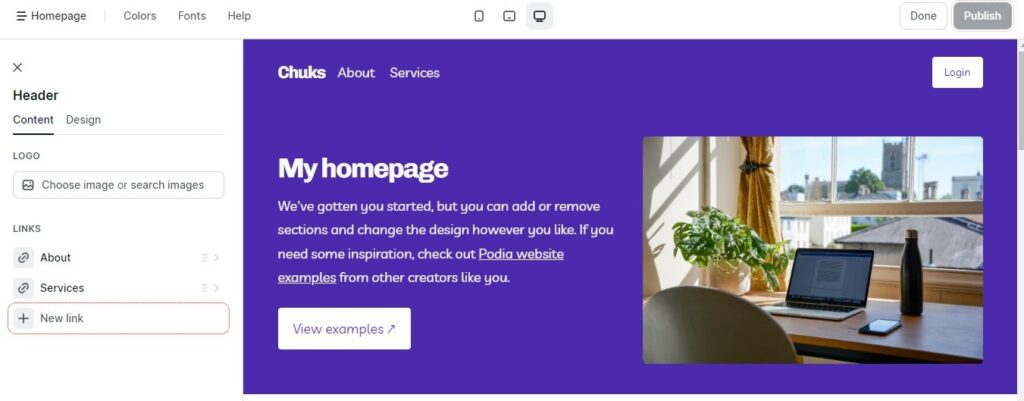
Here you edit and customize this template to suit your needs. You can change fonts, colors, appearance, and background and make other changes to give your website a new look.
This template is useful if you plan to have a membership site, or even start a blog to promote your digital products. When you’re done customizing, click Done and publish it.
Again, Podia by default offers you a free domain which is an extension of their own domain. But you can add your own custom domain to look professional.
Podia affiliate marketing
To help you make more sales, Podia supports you to create an affiliate program for your digital products. When you log in to your account, navigate to the Audience tab, click the drop-down arrow, and select Affiliate.
Then click Settings to set up an affiliate program for your digital product.
You will see how people can join your affiliate program, option to set the percentage commission you will pay for each sale, and products you want to create affiliates for.
There is also a button to invite affiliates to join your affiliate program.
When an affiliate joins, navigate to the Affiliate tab to see them. Navigate to the Sales tab to track invoices, referrals, products, etc.
Click the Overview tab to view all key metrics at a glance: Sales, Revenue, Paid, Unpaid, Clicks, and Conversion.
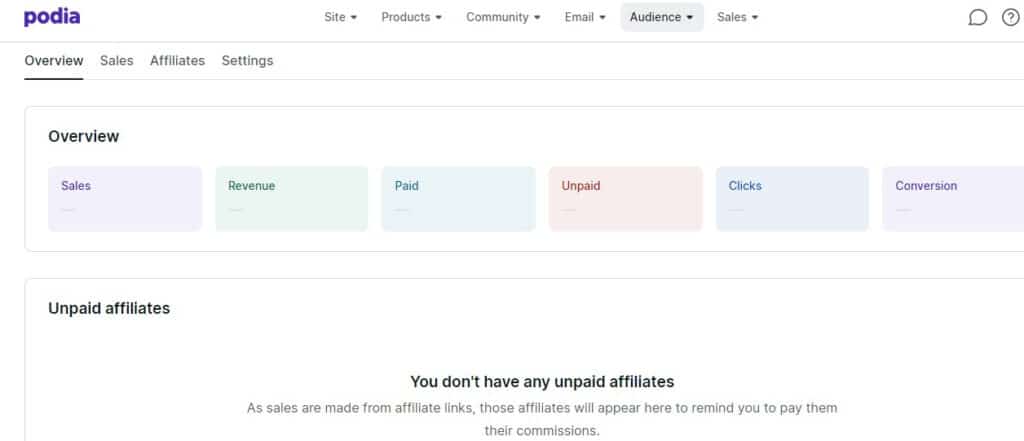
Keep in mind that the affiliate feature is only available on Podia’s paid plans.
Messaging
The messaging feature makes it easy to turn visitors into customers. You can activate this feature so a visitor who lands on your site can message you.
This gives you room to interact with them, explain to them what they will benefit from your digital products and by doing so give them reasons to become leads.
It’s also an avenue to answer post-purchase questions your customers may have. This feature is fully integrated into your website, so you don’t need a third-party app.
Custom website
Podia allows you to build a custom website. It may be a single landing page or a full website. And there is a pre-made template you can leverage to design your website.
Podia Integration
Podia integrations with third-party tools. So you don’t have to give up your favorite marketing tools.
There are 3 different ways to connect your tools to Podia:
Native Integration – connect your email tool, advertising tool, payment processor, webinar tool, analytics tool, and scheduling tool from inside Podia.
Iframely Embeds – Podia supports you to embed over 1900 tools into your website without a line of code. Just copy a link from Spotify, YouTube, Twitter, Google Forms, or any other tool you want to embed. Paste at the spot you want it and hit publish. That’s all, you have embedded the tool.
Zapier Integration – Connect Podia to any workflow that will help you as a creator using Zapier. With Zapier, you can trigger and automate things across your platform.
How to set up a course on Podia?
Step 1
Choose a plan on Podia, sign up and log in to your account, and select Create a product:
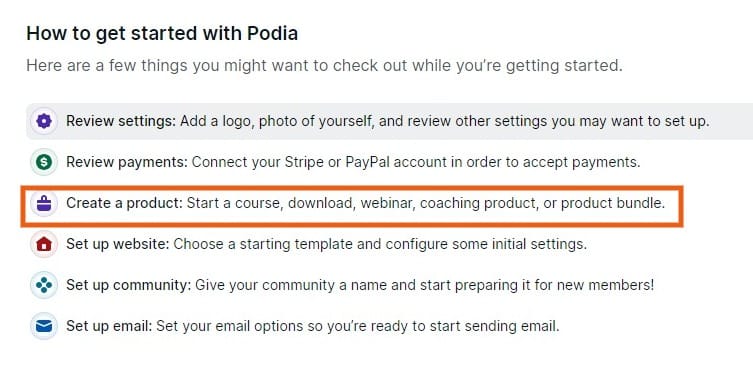
Step 2
Name your new digital product, select online course, and click Create product:
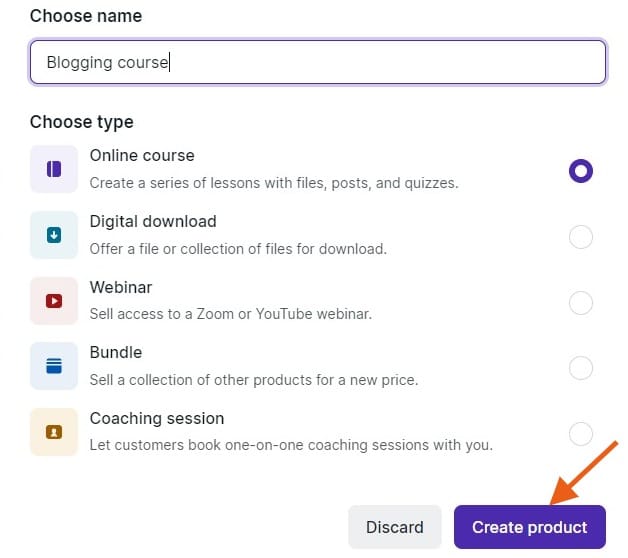
Step 3
Add lessons to your course.
This could be texts, embeds, quiz, coaching, and files. For example, section 1 of your course can be a video lesson of 6 minutes, its translation to text, quiz to test understanding of your student on what they learned.

You can always add new lessons to a section and also add new sections.
Step 4
Set details of your course.
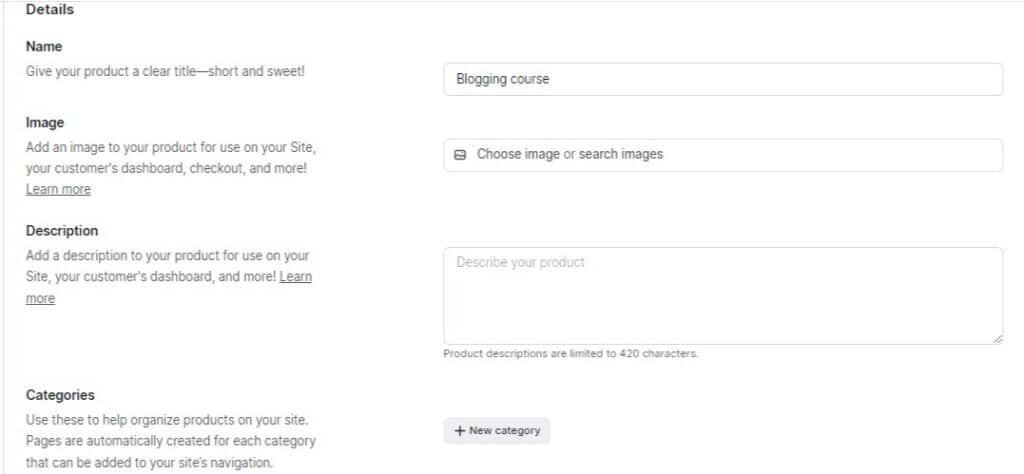
Here you give your course a name, choose a suitable image for it, and write a description for it. You can also add it to a category to help keep your digital products organized.
Step 5
Set a price for your online course.
You can make your course free or set a price for it.
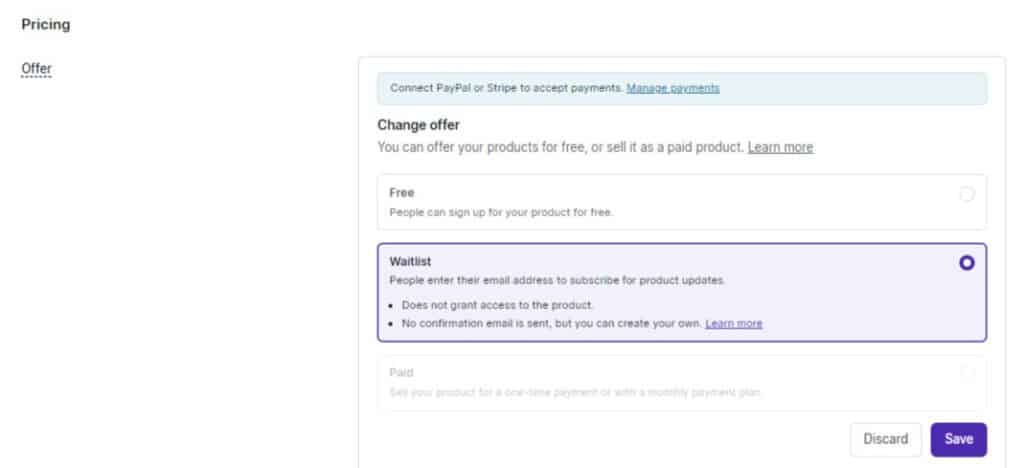
If you want to make it free, select Free.
But if you want to sell, you have to connect PayPal and Stripe which are two options to accept payment on Podia for your digital products.
After that, set a subscription plan which can be one-time, monthly, or yearly.
Another feature you can use on the pricing of your course is the waitlist. Your audience will enter their email address to subscribe to updates on your course.
Click save if everything looks okay.
Step 6
State the availability of your online course.
You can make your course a draft until you’re ready to make it live.
Even when it’s live, you can still make it visible or hidden. Let’s assume you identified an error in your course after you published it.
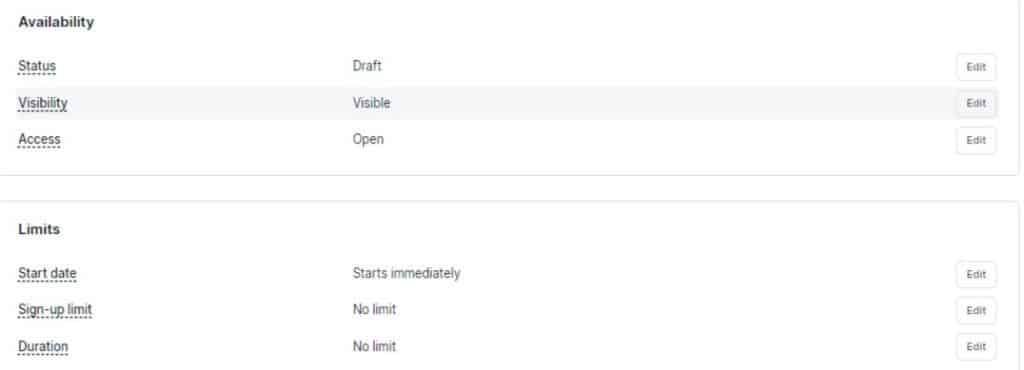
You can use this feature to make it hidden, correct the error and make it live again.
You can set limits. Like when your audience will access your course – immediately or a set date.
There is an option to set sign-up limits. Let’s assume you want only 200 students for your course, so you can adequately attend to them via chat or call, you can set it.
If you choose to set a limit, an integration with Zapier will handle the course and ensure the limit isn’t exceeded.
You can also set a duration limit to determine the number of days customers can have access to your course.
Step 7

Go through the course you have created, check if everything looks good. If yes, click Done and hit the Publish button.
Step 8
Manage your course.
Navigate to Products and select all products to see online courses you have created. Click the 3 dots and you see options to manage your course. You can edit and customize a sales page to promote your course.

After customization, you can view your sales page. There are options to share your online course, export customers, view sales, or even delete the product you have created.
After publishing your course, it has a Podia domain extension which doesn’t look professional. You can add your own custom domain if you’re on any of the paid plans.
How do coupons work on Podia?
A creator creates a coupon code and offers it to his target audience for they to get any of his digital products – online courses, digital downloads, memberships, and subscriptions at a discounted price.
The audience at the point of purchase enters the coupon code which is usually a combination of alphabets and numbers to get the discount.
For example, a course creator on Podia might offer a 20% discount for their course which costs $100, and ask you to use “XYZ22” coupon code to get the discount. If you apply the coupon at the checkout page, you will pay $80 for that course instead of $100.
How can I create coupons on Podia?
Login to your Podia dashboard and navigate to the sales tab. Click the drop-down arrow and select New Coupons.

To create a unique coupon code for a special season like Christmas or Halloween, use a descriptive coupon code like HALLOWEEN-20OFF.
Alternatively, click on Generate unique code to use any coupon code Podia generates for you. Share it with your potential customers to get a discount when they want to buy your digital product.
Note: This feature is available only on Podia’s paid plans.
Also, Podia accepts only alpha-numeric characters as coupon codes. Spaces will be converted to dashes (-) while any special character will be removed.
Podia alternatives
Podia isn’t the only platform where creators can create and manage their digital products. It has alternatives that are also competitors. So feel free to consider the following Podia alternatives I listed below:
- Learnworlds
- Kajabi
- Teachable
- Thinkific
- Gumroad
Let’s Compare Podia to its competitors
Podia vs Learnworlds
Podia is simple to use, and its features are centered towards helping digital creators. Learnworlds has advanced features for creators, but it may not be easy for you if you are a beginner course creator.
The most striking thing about Learnworlds is its online school features that provide you with the tools you need to run an interactive online class. When it comes to pricing, the difference isn’t much. Learnworlds has the Starter plan which costs $29/month, Pro Trainer plan which costs $85/month, Learning Center which costs $255/month and Learning Center + Mobile App which costs $509/month.
Read this article where I did a Learnworlds vs Podia comparison.
Podia vs Thinkific
Just like Learnworlds, Thinkific offers advanced features for course creation. One of them is the pre-made templates for course creation. You can just pick a template, edit and use it to build your course. Podia lacks templates which makes it easy to create a course. When it comes to email marketing, Thinkific isn’t a match to Podia. While Podia has all the email marketing features you need to promote your course as in-built, Thinkific offers little, relying heavily on third-party email marketing tools which is an additional cost.
In terms of pricing, Thinkific is expensive compared to Podia. Its Basic Plan costs $49/month, Starter Plan costs $99/month, Growth Plan costs $199/month, and the Plus Plan, a custom pricing.
Podia vs Kajabi
Kajabi is a powerhouse when it comes to designing and customizing your online course and other digital products. It offers features like pre-made templates and branding options which Podia lacks. But when it comes to affiliate marketing features, Podia does better than Kajabi. It provides the tools you need to empower your affiliates and track dashboards. In terms of pricing, Kajabi is far more expensive than Podia. Its Basic Plan which costs $149/month is more than 3X of Podia’s Mover plan which costs $39/month.
Read this article where I compared Podia and Kajabi.
You may also like this article where I compared Kajabi to Teachable.
Podia vs Teachable
Just like the name sounds, Teachable offers more advanced features for teaching and learning. Examples are graded quizzes, certificates, and content lock. Podia has better affiliate and email marketing features. Also, Podia offers more advanced features for creating membership sites than Teachable. Their site design and customization features look similar. Both offer you a free subdomain by default to host your course until you are ready to use a custom domain.
They also offer backup and maintenance services, so you can focus on converting leads to sales.
In terms of pricing, Podia is more affordable compared to Teachable which has its Basic Plan at $59/month, Pro Plan at $159/month, and Business plan at $665/month.
Podia vs Gumroad
Gumroad operates like an ecommerce platform with a storefront where you can display and sell your digital products. Podia possesses such features but goes beyond creating a simple digital product. You can use Podia to create full-fledged online courses, memberships, and subscriptions. Gumroad acts as a middleman between you and your customers. It collects payment on your behalf and pays you on a schedule.
Podia doesn’t act as a middleman. Instead, it allows you to have a white-label platform for your products where your target audience will have an account on your website rather than Podia’s.
While Podia charges a subscription fee, Gumroad doesn’t, it instead takes a percentage from every sale you made.
Does Podia charge a transaction fee?
If you’re on the free plan, Podia will charge you a transaction fee of 8%. That means for every sale you make from your digital product, Podia takes 8% of it. But if you’re on any of the paid plans like Mover, Shaker, and Earthquaker, Podia doesn’t charge you a transaction fee. You keep 100% of the money you make from the sale of your digital product.
What is Podia best for?
Podia is best for course creation, memberships, digital downloads, subscriptions, and coaching. For any of the businesses you want to run on Podia, it has features that support you as a digital creator.
Does Podia have a free trial?
No, Podia doesn’t have a free trial. But it has a forever-free plan which is enough for you to have a feel of what Podia has to offer before you commit to it.
How many memberships can I have on Podia?
You can only have 1 membership ( community) on Podia.
Does Podia have an app?
Podia doesn’t have an app, whether an Android or iOS app.
What should I pay my affiliates on Podia?
It’s up to you to decide what you want to pay your affiliates on Podia. Keep in mind the higher your affiliate commission, the more you attract affiliates who will sign up and promote your digital products. That’s a win-win. You make more sales, your affiliates earn a commission for promoting your products.
Final thought on the best Podia pricing for you
I trust you now understand what each of the pricing plans of Podia got to offer. The Mover plan which costs $39/month is for beginner creators who want to see how far they can go creating and selling digital products like courses, digital downloads, memberships, etc.
The Shaker plan offers more advanced features like affiliate programs, embedded checkouts, webinars, and Zapier actions. It’s for creators who want more marketing tools Podia offers to help grow their sales.
The Earthquaker plan offers the best features with onboarding calls and monthly creator calls being two of its striking features.
In all, Podia is a beginner-friendly and easy-to-use online course platform. It’s also affordable compared to Kajabi, and Thinkific. It’s up to you to compare the features each of the plans offers, weigh them against what you want in an online course platform, and make a choice.


